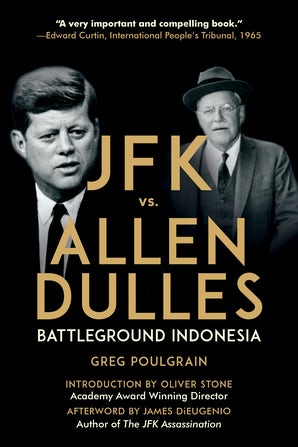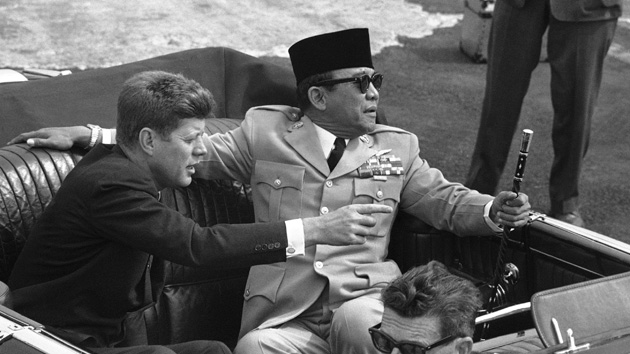Ian Chalmers
This challenging book will draw the attention of both the expert and the general reader interested in Indonesia. Its focus is on 1965, President Sukarno’s ‘year of living dangerously’, a year marked by the failed coup attempt of the 30 September movement and Suharto’s successful counter-coup. Much has been written on these events, especially as more of Indonesia’s ‘hidden history’ has come to light since its democratisation. But this book gives us an important new perspective on this tumultuous year, and is likely to generate much debate both within and outside Indonesia.
Greg Poulgrain is a senior lecturer in history at Queensland’s University of Sunshine Coast, who for many years has researched the politics and history of Southeast Asia. His research has focused on its place in global politics, and the main theme of this book is that Indonesia was a crucial arena for the struggle between two political ideologies within the US establishment. During the Cold War of the 1960s global powers such as China, USSR, United Kingdom and the USA all sought to turn political developments in Southeast Asia to their favour. But the region was also an arena for conflict within the US administration itself, where policy on developing countries was essentially a contest between two competing visions. On the one hand, advocates of a ‘security approach’ sought to maintain US dominance by encouraging authoritarian rule, with US backing.
By contrast, advocates of ‘engagement’ with emerging Third World countries proposed large-scale development aid programs to win their support. The tension between these two approaches is neatly captured in the rivalry between the two main characters of this book: one-time Director of the CIA Allen Dulles, and President John F. Kennedy, who came to power with a reformist agenda in 1961. We learn here that Indonesia was a turning point for this contest, for it was in 1965 that the security approach won out.
This theme is summarised in a fine Introduction by Oliver Stone, the controversial author and director of the thriller ‘JFK’, a film alleging a political conspiracy was behind the assassination of president Kennedy in 1963. He writes that, with Poulgrain’s account of the CIA’s success in Indonesia, ‘probably no author has explained just how pre-planned and well-executed the year of living dangerously was. Let him be your guide’.

For readers of Inside Indonesia, the most relevant chapter is undoubtedly the final Chapter 7, entitled ‘Suharto and 1965’. It provides a useful summary of various accounts of the coup, but also draws on the authors’ interviews with key players to argue convincingly that Suharto himself knew about the coup in advance – and was himself probably involved in its design. As stated in an interview with Colonel Abdul Latief, a key member of the 30 September movement who was soon imprisoned for over 33 years, ‘Suharto was one of us’. The likelihood of Suharto’s involvement is further supported by numerous interviews with key intelligence, political and military personnel, such as the former chief of the armed forces, General Nasution. This chapter amply shows us one of the strengths of the book, namely the way in which interviews with key informants are used to flesh out the story.
The argument is also supported by careful examination of official communications and the timing of announcements made at the time. For example, we learn that Suharto had already sent a local military command an order to attack a PKI branch several hours before the movement announced that it was taking control and standing down Sukarno’s cabinet; ‘Even though the evidence has emerged half a century after the event, it is evidence [Suharto] was on the inside of the movement and participated in the death of the six generals as a means of achieving control of the Indonesian army and, ultimately, political power’.
The novel perspective this book offers is that it shows how these events reflected a struggle between the CIA and reformist President Kennedy. To understand this rivalry the reader should go back to Chapter 1, ‘JFK and Allen Dulles’. It describes the long career of Dulles, who had been involved in legal battles to protect the business interests of the huge Rockefeller corporation since the late 1920s. In the mid-1950s he began implementing what Poulgrain calls his ‘Indonesia strategy’, aiming to protect American business interests by strengthening the role of the military. In the early 1950s he had become head of the CIA which, in Asia, increasingly focused its efforts on Indonesia. This strategy was challenged by Kennedy, who sacked Dulles in 1961 and signalled a new approach. Although Dulles still had great influence and was able to draw on a network that he had developed over decades, Kennedy wanted to use the power of the presidency and his warm personal relationship with Sukarno to promote a huge aid and development program to cement US-Indonesia ties. JFK planned to visit Jakarta in early 1964, when he and Sukarno would jointly announce this program. As we know, JFK’s assassination meant this visit never occurred. The development plan sank without trace, leaving Dulles’s CIA free to further its own scheme of political intervention to protect international business interests.
The material between these two opening and closing chapters draws on decades of research to provide fascinating background information on a number of related topics. Chapter 2 recounts how three Dutch geologists exploring the inhospitable highlands of Papua in 1935-36, chanced upon what turned out to be the richest gold deposit in the world. Remarkably, these geologists and the Dutch colonial rulers were able to keep this discovery secret for decades – as has the huge American-owned ‘Freeport’ mining corporation which still mines this region.
Chapter 3 recounts Dulles’s long-standing employment with Standard Oil (Caltex) from the 1930s, and details the efforts he took to preserve their interests in Indonesia in the following decades. Chapter 4 presents a rather complex (and more contentious) argument that Dulles and the CIA took a leading role in first encouraging and then quelling a rebellion in the outer islands of Indonesia in 1958, with the specific purpose of installing the centralised military command which finally took control in 1965.
Chapter 5 explores the instrumental role Dulles played in preventing democratic change in developing countries during the Cold War. We read of reports by a UN investigation team that Dulles was involved in the 1961 assassination of both President Lumumba of the Congo and the Secretary-General of the United Nations, Dag Hammarsjkoeld, who had planned to shortly announce a huge UN development scheme for Papua and other developing nations.
Chapter 6 is a complex and somewhat disorganised chapter, describing the impact on Southeast Asia of Cold War rivalry in 1961-63. It contains some interesting anecdotes, such as that concerning the death of Michael Rockefeller, the young son of New York Governor Nelson Rockefeller. While searching for Asmat artwork on the south coast of Papua in Nov 1961, he was swept out to sea during a boating mishap. He disappeared, and his body was never recovered. Foreign oil workers spun a story of him being ‘eaten by cannibals’, a story then picked up by the national and international media. This reinforced the colonial narrative that Papua was full of ‘savages’ and not really ready for self-rule, one that is still heard today in the independent Indonesia. ‘His disappearance became a media event that was closed off to any other explanation, and the political implications of his disappearance became an ongoing tragedy for the Papuan people’, Poulgrain writes. This little story shows how much such historical events still resonate.
This book deals with large themes and has big ambitions, most of which are achieved. It contains a great deal of useful information about a complex history, and anecdotes such as the story of Michael Rockefeller are used to good effect. But it would have benefited from a tighter structure and stronger editing, for different sections often present us with information provided elsewhere. (The occasional repetition of data also suggests that some chapters draw on earlier publications or papers).
But these are minor quibbles, and there is much to like here. The language is clear and straightforward, making it readily accessible to the interested reader seeking information on these various topics. The data that has been collected here will also make it valuable for students of American politics, of international relations and US foreign policy, and for scholars of the recent history of Indonesia and Papua. There is a useful index, a timeline of events and brief biographies of the almost 200 individuals mentioned in the text. The copious endnotes citing official documents, reports and scholarly texts ensures that this book will be mined for information well into the future. It is the sort of text that will require updating as new information comes to light, and one hopes that future editions will be even more useful.
Greg Poulgrain, JFK vs Allen Dulles - Battleground Indonesia, 2020, New York, Skyhorse Publishing. The e-book is available for sale here.
Ian Chalmers (ian.mc.chalmers@gmail.com) is an adjunct senior lecturer in social sciences and Asian Studies at University of Western Australia.












